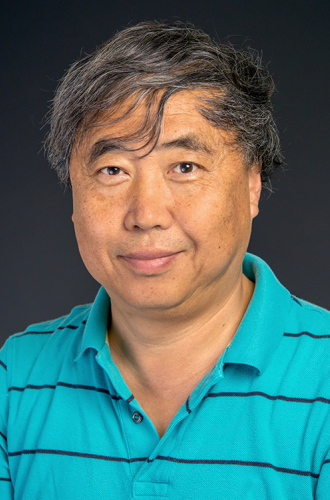-

-

-
Qian Niu (Retired)
Condensed matter theory; quantum Hall effect; nanostructures and quantum devices; quasi-periodic systems; vortex dynamics-
Ph.D., University of Washington, Seattle (1985)
Research Interests
Condensed matter theory; quantum Hall effect; nanostructures and quantum devices; quasi-periodic systems; vortex dynamics.
Like many young people, I wanted to be an engineer for practical reasons, but I accidentally entered physics when Peking University picked me into their physics department in 1977, the first year China restored its college admission system after the cultural revolution. This was really a fortunate accident, because I found myself loving physics ever since. The most amazing thing about physics is that it presents a coherent view of the world around us. Physics theory and its beautiful mathematics really works. One can make predictions and do experiments to verify them not only qualitatively but also quantitatively. I sometimes feel superior as a physicist, because we know the world much better than most people.When I started working on my Ph.D., I began to learn that the world is actually more mysterious than I thought. This was not because my initial impression of physics was wrong, but because, by that time, I had acquired a higher standard for understanding the world. This was the time when I began to see the boundary between our coherent knowledge and the unknown. Working in this frontier of knowledge is what we do in physics research. I have gone through the typical career stages as a graduate student, a postdoc, and as a professor, initially with guidance from my mentors, then becoming independent and starting guiding younger people myself. We physicists travel to many places in the world and meet all kind of smart people. We look for puzzles and solve them. We pick up small pieces of knowledge and fit them into the coherent theory of physics. We have great fun playing this kind of game, but it also comes with a lasting satisfaction as we contribute to building this ever greater body of physics for humankind.
This frontier is expanding in all directions. Some of my colleagues study extremely high energies and small length scales; some go to extremely low temperatures and seek ever precise control of atoms; and some try to solve the energy crisis of our society once and for all. Some people, including myself, try to achieve a clear understanding of condensed matter, including solids and liquids, where things are very complex. My particular specialty is to see how geometry and topological principles emerge in the quantum mechanics of condensed matter. Such principles are highly valued because they seem to govern a really diverse set of phenomena. You can have a look of my CV for a more close-up description of this kind of research.
-
Research Highlights
"Universal electromotive force induced by domain wall motion" Shengyuan. A. Yang et al., PRL 102, 067201 (2009)
The electromotive force induced by a moving magnetic domain wall in a nanostrip has been calculated theoretically and detected experimentally. It is found that the emf depends only on the domain wall transformation frequency through a universal Josephson type relation, which is closely related to the topological nature of the domain wall. Our experimental measurements confirm the theoretical prediction.
"Valley-contrasting physics in graphene" D. Xiao, W. Yao, and Q. Niu , PRL 99, 236809 (2007)We investigate physical properties that can be used to distinguish the valley degree of freedom in systems where inversion symmetry is broken, using graphene systems as examples. We show that the pseudospin associated with the valley index of carriers has an intrinsic magnetic moment, in close analogy with the Bohr magneton for the electron spin. There is also a valley dependent Berry phase effect that can result in a valley contrasting Hall transport, with carriers in different valleys turning into opposite directions transverse to an in-plane electric field. These effects can be used to generate and detect valley polarization by magnetic and electric means, forming the basis for the valley-based electronics applications.
Selected Publications136. "Statistical Mechanics of an Optical Phase Space Compressor", A. M. Dudarev, M. Marder, Q. Niu, N. J. Fisch, M. G. Raizen, physics/0502056 (2005).
137. "Berry phase correction to electron density of states in solids", D. Xiao, J. Shi, Q. Niu, cond-mat/0502340 (2005).
138. "Disorder effects in the AHE induced by Berry curvature", N.A. Sinitsyn, Q. Niu, J. Sinova, K. Nomura, cond-mat/0502426 (2005).
139. "Fidelity of a Bose-Einstein Condensate", J. Liu, W. Wang, C. Zhang, Q. Niu, B. Li, cond-mat/0503036 (2005).
140. "On A Proper Definition of Spin Current", P. Zhang, J. Shi, D. Xiao, Q. Niu, cond-mat/0503505 (2005).
141. "Charge Hall effect driven by spin-dependent chemical potential gradients and Onsager relations in mesoscopic systems", E. M. Hankiewicz, J. Li, T. Jungwirth, Q. Niu, S. Shen, J. Sinova, cond-mat/0505597 (2005).
142. "Berry Phase Effect on Semiclassical Dynamics of Bogoliubov Quasiparticles", C. Zhang, A. M. Dudarev, Q. Niu, cond-mat/0507125 (2005).
-
- Trull Centennial Fellowship (1990-1992)
- Blumberg Fellowship (1992-1993)
- NIST Precision Measurement Award (1992-1995)
- Outstanding Overseas Young Scientist (1999, Natural Science Foundation of China)
-














